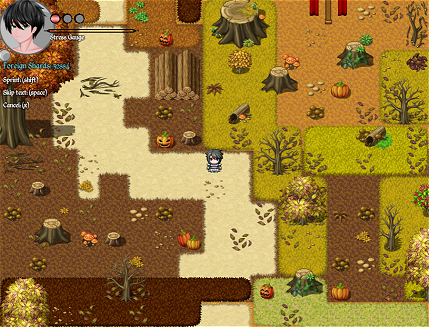Hello:
Here now, take a look at this map section:

Despite the fact it's not Pico-8, it is interesting to look at. It is clear there is a meandering path going from north to south yet there are all kinds of tiles and obstacles along the way.
This map was drawn by hand by a map artist I am certain, is why it looks so good and able to explore.
Yet it brings up an interesting point. Are we intelligent enough today in our coding - can we develop code that can create a map like this ? Where it is not only aesthetically pleasing to the eye it also offers a challenge to travel through if you stray from the obvious path.
It might even be a set of rules like:
Map size is 64x64 32 small rotted stumps on dirt 24 rotted stumps on dirt 24 green stumps on grass 24 pumpkins 18 large trees 36 dead trees 48 small pumpkins 32 medley pumpkins 16 large pumpkins 18 bloom trees on red grass + Standard North/South Path through using pressed yellow leaves, twistiness = 114 |
That would just barely scratch the surface I think as you would still need to procedurally generate the land it is on. Ensure a path through even though you would have to wind up, down, left, and right, to get through at times.
What mechanics would be involved in generating something like this ?
What are your thoughts on this ?

Book: Procedural Generation in Game Design: https://www.routledge.com/Procedural-Generation-in-Game-Design/Short-Adams/p/book/9781498799195
On Spelunky (for example):
- Interactive article: Spelunky Generator Lessons by Darius Kazemi: http://tinysubversions.com/spelunkyGen/
- Video: Game Maker's Toolkit on Spelunky level generation: https://www.youtube.com/watch?v=Uqk5Zf0tw3o
- Book: Spelunky by Derek Yu: https://bossfightbooks.com/products/spelunky-by-derek-yu
Roguelike Celebration routinely has talks on procedural level generation. Video archives: https://www.youtube.com/channel/UCKv_QzXft4mD6TXmQBZtzIA
- Procedural Map Generation Techniques by Herbert Wolverson: https://www.youtube.com/watch?v=TlLIOgWYVpI
- Procedural level design in Brogue and beyond by Brian Walker: https://www.youtube.com/watch?v=Uo9-IcHhq_w
- Keeping Procedural Generation Interesting by Darius Kazemi: https://www.youtube.com/watch?v=CLi4PWxDmAI
- etc.: https://www.youtube.com/channel/UCKv_QzXft4mD6TXmQBZtzIA/search?query=procedural
A general idea I like is mixing authored content with generated content. The first time this clicked for me was Diablo, which generates its dungeons but always makes sure the bosses are evenly placed and surrounded by whatever is needed to make them fun or tell the overall story.

@dddaaannn, the voice of reason.
I need to get a rubber stamp for that.
WOW ! You have REALLY provided me with some excellent material to go over. Now years ago I did draw maps and stuff. You know, I had fun. Today - my map-making skills are par minimal.
I just - don't know what goes where and why. I guess it is a lack of confidence. And I'd rather have a computer generate the map if it can, especially for something as lush and beautiful as the above picture.
And it seems - today - we can. And that is exciting territory for me. Not only does this method provide a unique experience each time you run it, you get something quite lovely like the above which just cries to be explored and to discover its secrets.
Interesting stuff ! You have provided me with quite a bit more than I asked for, and I thank you for that !

Wave function collapse is an interesting technique for doing this kind of thing. It takes an input image (a section of the map data maybe) and will output a map of whatever size you want which is similar to the input.
There are a couple demos of it here of the BBS.
The first let's you change the input so you can see what kind of different results you can get. The second doesn't have instructions but if you press 🅾️ it advances the algorithm one step while pressing ❎ speeds through a bunch of steps at once.
And here's a youtube video discussing the technique as used in the roguelike game Caves of Qud: https://www.youtube.com/watch?v=AdCgi9E90jw

Hi @jasondelaat:
It is nice to know this is mainstream and considered. I will certainly take a look at the videos you have described.
Thank you !
[Please log in to post a comment]







